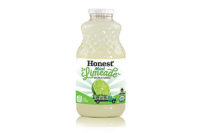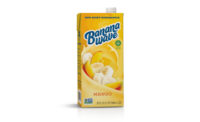Consumers know that consuming fruits and vegetables is important, but nearly half believe they do not consume enough, according to the Produce for Better Health Foundation (PBH), Hockessin, Del. Although the PBH’s survey found that primary shoppers believe they consumed more fruits and vegetables in 2014 than in 2012, roughly one in three eat less than a cup of fruits and less than a cup of vegetables each day. In addition, one in four shoppers think consuming fruits and vegetables is a chore.
Beverages tend to be a convenient vehicle for consumption of many types of fortified ingredients, experts note, but 11% of shoppers do not believe that 100% fruit juices and 100% vegetable juices are healthy, according to the PBH’s 2014 report “Primary Shoppers’ Attitudes and Beliefs Related to Fruit & Vegetable Consumption: 2012 vs 2014.” Although 65% of primary shoppers agree that 100% fruit juices and 100% vegetable juices are healthy, this number is down from 79% in 2012, it reported.
The PBH study also found that consumers with annual incomes of less than $50,000 were more likely to rate 100% fruit juices and 100% vegetable juices as healthy, compared with consumers who make more than $50,000 annually. However, the PBH infographic reports that 100% juices are both an economical and nutritious form of fruit and/or vegetable consumption.
When it comes to thirst-quenching options, consumers also are choosing beverages in categories that they deem healthier than juice, Los Angeles-based IBISWorld reports in its October 2014 report “Juice Production in the U.S.”
“In line with this trend, marketing campaigns that promote stimulants or natural ingredients have encouraged the surge away from the juice production industry’s sugary juices… toward functional and energy drinks and ready-to-drink teas,” the report stated.
To re-bolster the juice category within the beverage market and change consumer opinion, education about the nutritional benefits of 100% juices will be key, Mintel noted in its report.
Analysts recommend that juice brands amp up their health images by adding nutrient-dense pulp, a fresh-squeezed quality, portion control, or other premium attributes.
“Single-serve options, premium juices and super-premium juices remain the bright spots of the category,” said Howard Telford, beverages analyst at Euromonitor International, Chicago. “While overall volumes remain in decline, the smaller, premium single-serve juices have outperformed. Organic 100% juices demonstrated high single-digit value growth for the year.”
Overall, smoothies remain popular for home consumption, and the segment continues to see robust sales of premium blenders, Euromonitor’s Telford says. The refrigerated juice and juice drink smoothies segment grew nearly 9.5% to more than $815 million in the 52 weeks ended Nov. 2, 2014, according to IRI.
Blended success
Beyond premium attributes, fruit juice brands also can enhance their health image by adding vegetables to the mix. Euromonitor’s Telford noted that the market research firm is seeing consumer interest in green juices with green vegetable content.
IBISWorld also reported that the fruit-and-vegetable juice segment has been showing growth over the last five years. “Green juices with green vegetables have become increasingly common, using items such as spinach, kale, parsley, romaine, cucumber and celery, often combined with a fruit to sweeten the taste,” it stated in its report.
In total, vegetable juices made up 5.1% of the juice market in 2014, with citrus juices claiming 57% share and non-citrus juices making up the remaining 37.9%, IBISWorld reported.
Flavor twist
Although healthy, premium attributes are a big part of the consumer purchase decision in the juice and juice drinks category, taste rules, Mintel reported. Seventy-seven percent of surveyed consumers aged 18 and older said they buy juice and juice drinks because they like the taste.
The use of tropical flavors in fruit juices also can attract consumers by offering flavor variety, IBISWorld suggested. Mango and pineapple flavors have been on the rise as consumers seek creative, healthy products, it reported. In fact, shelf-stable bottled pineapple juice experienced nearly 18% growth to just more than $34 million during the 52 weeks ended Nov. 2, 2014, in IRI-measured channels.
Beyond these flavors, other exotic flavors like dragon fruit and papaya also can help attract adventurous consumers and meet the taste preferences of the growing U.S. Hispanic population, Mintel reported.
Tried and true
Even with multiple flavor options available on the market, consumers still are sticking to some of the more traditional juices.
Within the 100% juice category, orange juice still dominates, according to Euromonitor. The juice flavor controlled more than 60% of U.S. off-premise 100% juice sales in 2013, it reports. Apple came in a distant second with nearly 12% of the sales.
Other flavors in the Top 10 include mixed fruits with 9.3%, “other flavors” and tomato each with 4.3%, grape with 3.5%, cranberry at nearly 3%, grapefruit at just more than 2%, prune at 1.3%, and lemon with 0.3%, Euromonitor added.
In the future, Mintel expects the overall juice and juice drinks category to turn around as it evolves toward more healthful, calorie- and sugar-conscious options; explores flavor innovations; and meets the needs of key consumer demographics. However, future growth will depend on the category’s ability to present products as convenient and affordable alternatives to competing beverage options, it says.
This is an edited version of an article that first appeared in the January 2015 issue of Beverage Industry, a BNP Media publication (like Dairy Foods). It was reported and written by BI’s Jennifer Storelli and edited by Dairy Foods Associate Editor Sarah Kennedy.



